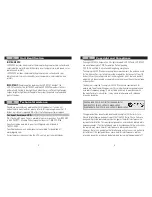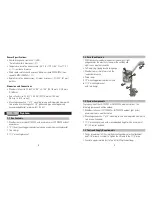
2
3
A.
Introduction
Thank you for purchasing DIG’s LEIT WWS (with wind sensor) or LEIT WWSE
(without wind sensor) wireless, ambient light (solar) powered weather station,
which operates as a part of the LEIT-2ET wireless, ambient light (solar)
powered irrigation system. This manual describes how to get the LEIT WWS or
LEIT WWSE weather station up and running quickly. After reading the manual
and becoming familiar with the basic functions of the weather station, the
user can refer to the manual for less common tasks in the future.
B.
About the LEIT WWS and LEIT WWSE Weather Stations
DIG’s LEIT WWS and LEIT WWSE wireless weather stations are independent,
column mounted, weather measuring instruments powered by ambient light
(solar). The LEIT WWS and LEIT WWSE weather stations continually gather
data on weather conditions from the surrounding area and simultaneously
transmit the data once every hour during daylight hours to any LEIT-2ET and/
or LEIT XRC-ETS controller at a distance of up to 350’ (100 m) line of sight. The
weather data collected and transmitted by the weather station’s sensors is
used in the calculation of the daily local microclimate evapotranspiration (ET).
The LEIT-2ET weather based wireless irrigation control system comprises the
LEIT-2ET weather based two-station ambient light (solar) powered irrigation
controller with a rain sensor connection, the LEIT RC2ET handset, and the
LEIT WWS or LEIT WWSE ambient light (solar) powered weather station. Site
information is entered into the LEIT RC2ET handset and is downloaded into
the LEIT-2ET controller. With the site information and the hourly weather
data received from the LEIT WWS or LEIT WWSE weather station, the LEIT-
2ET controller calculates the daily local microclimate evapotranspiration (ET)
and uses it to make a daily adjustment or override of the scheduled irrigation
program.
NOTE:
The LEIT WWS and LEIT WWSE wireless weather stations’ weather
condition data can be reviewed by the LEIT RC2ET remote handset. After
installation, no further visits to the weather stations are required.
Table of Contents
A. Introduction ………………………………………………………………… 3
B. About the LEIT WWS and LEIT WWSE Weather Stations ……………………… 3
C. Unit Identification …………………………………………………………… 4
D. Technical Assistance ………………………………………………………… 4
E. Copyright and Compliance …………………………………………………… 5
F. Features …………………………………………………………………… 6
1. System …………………………………………………………………… 8
2. Installation …………………………………………………………… 10
3. Quick Operation Review ………………………………………………… 11
4. Maintenance …………………………………………………………… 11
5. Warranty ……………………………………………………………… 12

























